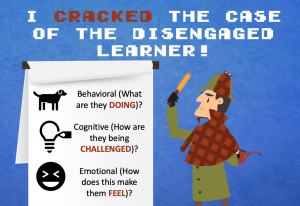I’ve been self-educating myself more in UX design and I came across a concept called Hick’s Law. Maybe I was drawn to it because the name made me homesick, but I wanted to explore how we can apply this to our learning experiences.
Hick’s Law, also known as the Hick-Hyman Law is named after a British and an American psychologist team of William Edmund Hick and Ray Hyman. I’m not sure why Hick’s name continues to stick on this. In 1952, they decided to examine the relationship between the number of stimuli present and an individual’s reaction time to any given stimulus. Hick’s Law predicts that the time, and by implication, the effort it takes to make a decision increases with the number of options. Behold my very non-fancy chart:

The formula for Hick’s Law is RT=a+b log2 (n)
Breaking this down, RT is reaction time, n is the number of stimuli present, and “a” and “b” are constraints that depend on the task and condition. A could be signing into the LMS and b could be finding the correct course to self-enroll in.
Hick’s Law is important when response times are critical. But it’s broader than that when applying this to L&D. For example, becoming the best widget maker takes time to learn how to build the components. By being able to deconstruct the components of the widget, it increases their ability as a widget maker. Hick’s Law works best for fast decisions without grave consequences. Hick’s Law does not apply to complex decision-making or decisions requiring reading, scanning, searching, or extended deliberation.
When response time is critical, keep it simple silly (KISS). Systems with fewer options are almost always rated as easier to use and more satisfying than similar products with more options. This reminds me of selecting faces for feedback versus filling out a survey. It turns out that abundant choice not only slows response time, it often leads to feelings of dissatisfaction and frustration.

Another implication of Hick’s Law is the need for emphasis. When a few items are designed to stand out, like a critical reporting function or frequently used option, you nudge users to where to select so response times can be quickened. This is why you don’t want critical functions like, let’s say, an ejection seat handle in an airplane mixed in with a bunch of other controls. If a pilot needs to eject, they need every millisecond we can give them. Making an option stand out achieves its objective.
Lastly, Hick’s Law underscores the need to reduce noise and distraction in decision-making contexts. This reminds me of Cammy Bean’s “clicky clicky bling bling”. When choices are presented with many distractions, the distractions effectively act like additional choices, slowing response time. This makes our courses full of sludge.
So, what are some instances you should apply Hick’s Law to in your learning experiences?










